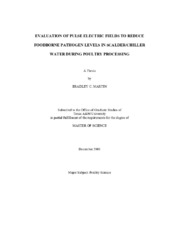| dc.description.abstract | Poultry slaughtering encompasses a series of processing steps with the objective
of harvesting the consumable meat. The scalding process consists of the submersion of
carcasses in hot water tanks to facilitate the removal of feathers during slaughter.
However, the use of a common scalding tank increases the likelihood of carcass cross
contamination considering that dirt, fecal material and even digestive and intestinal
contents carrying pathogens and other bacteria are widely spread during this operation.
Similar cross contamination occurs in the process of chilling carcasses, which also
requires submersion of broilers in communal tanks filled with ice and cold water. A
plausible approach to reduce contamination in scalders or chillers is the use of Pulsed
Electric Fields (PEF) to decontaminate scalder/ chiller water. PEF uses electricity to kill
bacteria suspended in liquid media and could be utilized in poultry scalders and chillers
to reduce bacterial contamination on carcasses and reduce the potential risk of pathogens
reaching the final consumer.
A pilot scale system was assembled by the use of a pulse electric field generator
(Model SF-700, Simmons. Eng. Co., Dallas, GA) coupled with a commercial scalding tank (Dunkmaster®, Knase Company Inc, MI). C. coli and C. jejuni along with marker
strains of Novobiocin and Nalidixic acid resistant S. typhimurium and S. enteritidis
strains were used in challenge studies evaluating the effects of the PEF on carcasses,
scalder and chiller water contamination.
The system was evaluated with 0, 0.5, and 1% sodium chloride in the water with
40 volts of electric current and 0.54 of amperage. Samples were collected at 0, 40, 80,
160, 200 s of treatment with a 10 s on, 5 s off cyclical pulses. The use of PEF in regular
scalder/chiller water showed little effect on Salmonella and Campylobacter reductions.
However, with the addition of 0.5% NaCl caused a significant (P<0.5) log CFU/ml
reduction of Salmonella and Campylobacter within the scalder/chiller water at 40, 80,
and 160 seconds respectively. | en |


